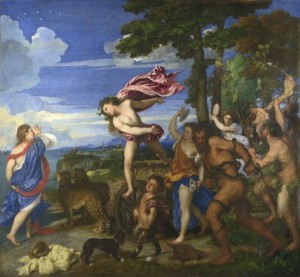PREVIOUS: HOLBEIN – THE AMBASSADORS
Titian: Bacchus and Ariadne:1520-23
After the static pictures we’ve just seen, this one explodes with life, as the god Bacchus leaps from his chariot to accost Ariadne, the mortal woman he has just seen and just fallen in love with.
The story comes from mythology, particularly their retelling by Roman poets such as Ovid and Catullus. One of the key aspects of the Renaissance in Italy was the rediscovery of these Latin texts, which became well known among the monied classes.
Ariadne was the daughter of King Minos of Crete. Minos’s son had been killed by the Athenians and as reparation Athens had to send seven young men and seven maidens every seven years to be sacrificed to the Minotaur – a savage creature, half man and half bull, kept in an impossible maze called the Labyrinth. One year Theseus, the son of the king of Athens, volunteered to be one of the sacrificial party in order to kill the beast. Ariadne helped him by giving him a knife and a ball of thread so he could find his way out of the labyrinth.
They eloped together and on there way back to Athens stopped overnight at the island of Naxos. Here, for reasons that are obscure, Theseus did the dirty on Ariadne and sailed off while she was sleeping, leaving her alone on the island.
Titian has capture the moment when Ariadne realises that Theseus has gone and is calling out in despair – you can just see his ship on the horizon by her left shoulder. At that moment out of the woods comes Bacchus – the god of wine and religious ecstasy – and his followers. We can see maenads, or wild women, banging cymbals, and satyrs, carrying barrels of wine and bits of dead animal for their feast. On a donkey on the right is Silenus, described as the oldest, wisest and drunkest of the satyrs. And the guy in the front is Laocoon, wrestling with serpents. A statue of Laocoon had been unearthed in Rome in 1503 and was very famous, so Titian’s picture is alluding to this.
Bacchus married Ariadne and as a wedding gift gave her a crown of stars – which we can see in the top left corner. So the picture gives us the past – Ariadne grieving for Theseus; the present – Bacchus falling in love; and the future – the wedding represented by the crown of stars.
Bacchus and Ariadne was painted for the Duke of Ferrara. It’s painted onto canvas – most of the paintings we’ve seen so far were done on wood – which meant that it could be rolled up and transported from Titian’s studio in Venice to the Duke’s palazzo. Art historians think that the dog in the foreground belonged to the Duke and that the cheetahs drawing Bacchuss’s chariot were from the Duke’s menagerie – in classical drawings these are usually lions or panthers.
And look at the colours – you can take a line from the bottom left to the top right and above that the colours are predominantly blue and we see brightness and light; below it the colours are generally browns and greens. And this splits the picture as well between the human and the godly sides, with Bacchus leaping into the side of the mortal Ariadne.
One final detail – inscribed round the urn on the ground is Ticianus Fecit – Latin for “Titian made this.” Now, after all this mythology, it’s back to the bible, with a picture from Rembrandt.


